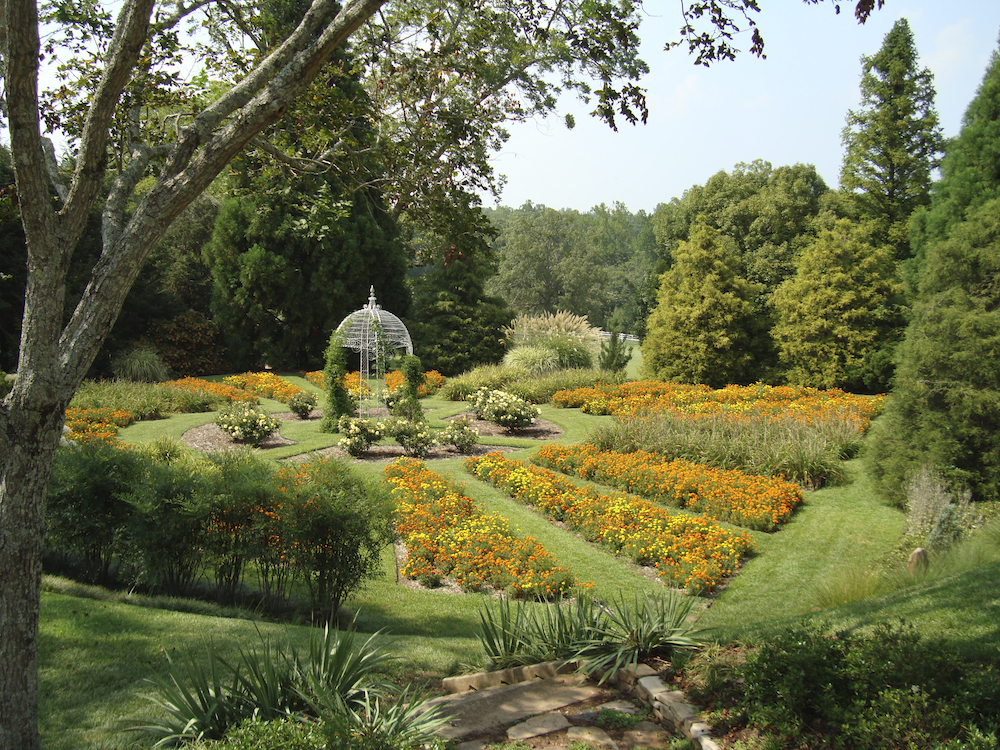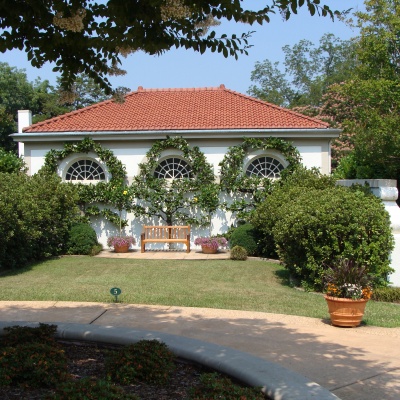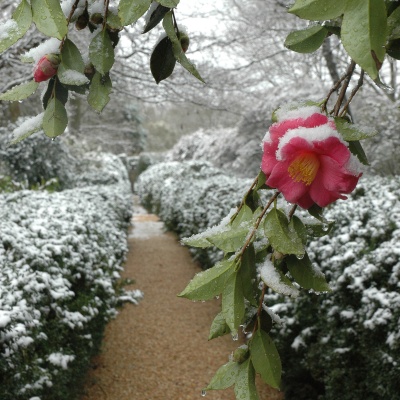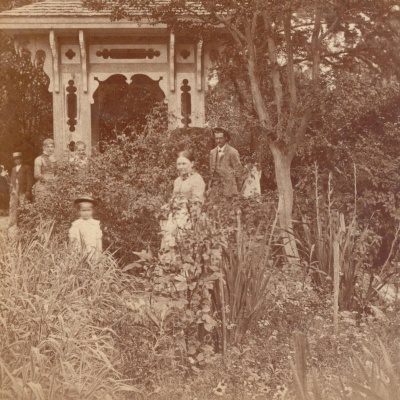The More Things Change

“Another addition has been a garden below the entry drive, in full view of the courtyard and seen by everyone coming to the house. The beds are in a spoke design, with a lacy metal gazebo covered with clematis in the center. It is easily maintained, with grass paths between the beds filled with plants chosen for both flower and foliage…”
So wrote Alice Callaway in 1984 about a garden she had installed in 1950 to provide a lovely view for visitors to see and enjoy, especially those whose stay was too brief to stroll Mrs. Ferrell’s boxwood garden. Today the bed arrangement remains the same in this area named “The Ray Garden” for the way the beds radiate out from the center. The garden continues to provide a view that is a favorite with guests of the estate, with the hemlock hedge and pecan trees beyond still framing an idyllic pastoral scene.
However, historic garden research shows that the area was not always used as an ornamental garden. Evidently, before Alice created the Ray Garden this area had been used as a fruit and vegetable garden by Mr. and Mrs. Fuller Callaway Sr.—although the design was very different. An aerial photograph from 1923 shows rectangular beds and a tall sheared hedge on the north side, likely planted to block cold winds. Fast forward about 18 years and another aerial shot pictures a clipped shrub hedge with an arched entryway that surrounded the garden on all sides. Rectangular beds are visible, as is a very small building surrounded by a fence—all within the hedged interior—that appears to be a coop and small yard, presumably for chickens. A decade later all of that was removed as Alice, by her own account, acted upon her vision for something beautiful rather than utilitarian for this area with its proximity to the house. Today, visitors often inquire whether Alice continued to grow vegetables after she converted this area to an ornamental garden, and the answer is “Yes!” She also loved to grow things to eat; her vegetable garden was relocated to an area just west of the greenhouse. However, the fate of the chicken yard remains unknown.
The initial transformation in 1950 involved the sunny, flat plain being planted with large beds of roses that were a Christmas gift from her husband Fuller Jr. Garden notes indicate that the area was then logically dubbed “The Rose Garden” and early photos from those years reveal the spoke design but no gazebo. Also gone was most, if not all, of the clipped hedge. Her records reveal that the hemlocks were purchased in September 1964 and it is assumed that they were planted shortly thereafter. The hemlocks, now fully mature, provide a tall, soft green backdrop to the west side of the garden. The rose garden remained here for some time but Alice remarked in later years that, although beautiful, the roses required so much maintenance that she had few regrets when age decreased their vigor and she opted to install a totally different palette of plants. And install she did! From 1970-1973, noted in her records was the acquisition of several dozen conifers of differing species and cultivars that were sited in what she now referred to as “the garden below the pool.” All were artfully arranged in long, narrow beds that framed the area on two more sides and allowed to achieve their natural form. The many that remain are now mature specimens providing backdrops for the north and east boundaries, with the individuality of each yielding a striking counterpoint to the geometry of the design within.
Photographs and lists in notebooks document what she selected over the years to fill the interior beds. A photo from the late 1960s shows 16 of the 24 spoke beds, plus the four surrounding the new gazebo, ablaze with color from celosia and mums. Blocks of daylilies can be seen dividing each quadrant, completing the sum. A classical statue was front and center of the hemlocks as it is now, but the white benches that are in the picture are no longer present. Changing out that many annual beds seasonally was undoubtedly labor intensive, and was perhaps the reason more of the garden’s beds became planted with perennials as the years passed. She began referring to this area as “The Lower Garden,” also recording that most of the annuals gave way to the likes of iris, candytuft, and lamb’s ear with boxwood and liriope skirting the gazebo. By the 1990s, only two to four beds were specced for seasonal plantings.
As fate would have it, the contents of this lovely spot have come almost full circle, not with a return to vegetables, mind, but many more colorful annuals. As a public garden open year round, uninterrupted color in highly visible areas is always desirable. The location’s sunny exposure makes it a natural spot for the visual appeal of blooming plants, so we have returned 16 of the beds back to the cultivation of showy annuals. Once again, they comprise four corner quadrants that are divided by beds of the same daylilies that Alice used. Paying homage to what were once here, ‘President Herbert Hoover’ roses (a cultivar grown by both Ida Callaway and Alice) now circle the clematis-covered gazebo. And yet another name change has occurred as well. Because a section in the historic boxwood garden has long been called “The Sunken Garden,” the concern arose that, due to the similarity between the names, visitors would confuse the two. “The Ray Garden” was the easy winner of the suggestions presented, being an epithet suitable for such a dramatic design. We hope that Alice would approve!


